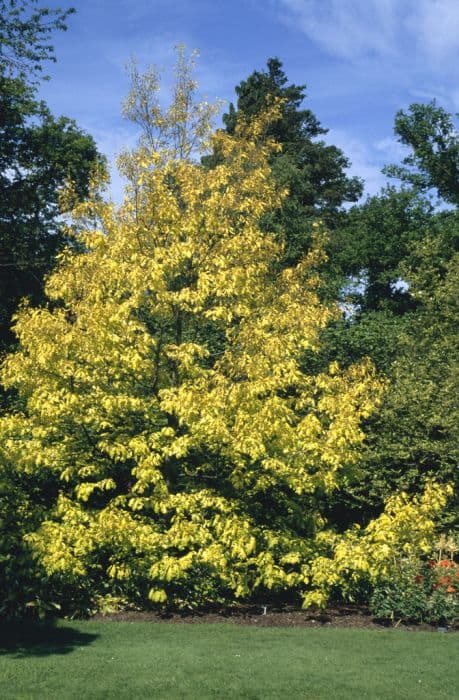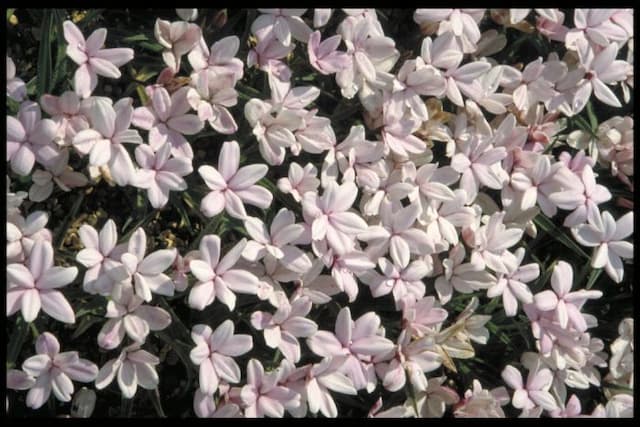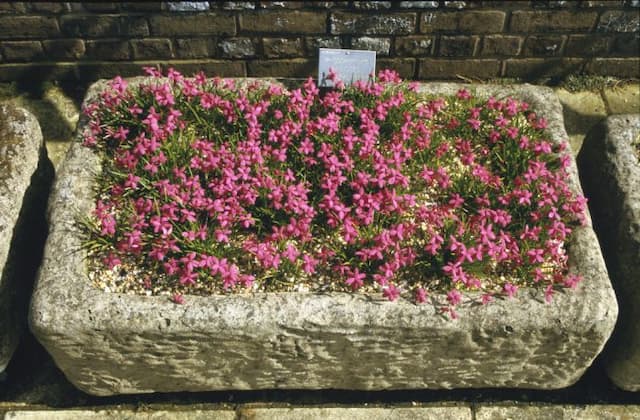Rhodohypoxis Rhodohypoxis baurii 'Apple Blossom'

ABOUT
The plant known as 'Apple Blossom' is a charming, low-growing perennial that bears attractive features that make it a favorite for garden enthusiasts. It forms a lush mound of grassy, slender green leaves that create a soft, tufted appearance. Throughout its blooming season, this plant showcases a profusion of delicate star-shaped flowers. The blossoms exhibit a pale pink hue, reminiscent of apple blossoms, with subtle color variations that may range from a blush to a more pronounced pink that is both gentle and alluring to the eye. Central to each flower is a soft yellow center that gives a beautiful contrast against the pink petals. The blooms are held just above the foliage, creating a delightful carpet of color when seen in abundance. Attractive to various pollinators, the flowers of 'Apple Blossom' add a touch of whimsy and a note of vibrant life to rock gardens, containers, or the front of borders where their beauty can be appreciated up close. Sturdy and resilient, the plant often spreads to form a neat clump which is particularly eye-catching when planted en masse. Even when not in flower, the tidy foliage of 'Apple Blossom' maintains an appealing presence in the garden, offering a plush green backdrop to neighboring plants. Its ability to bring color and texture to small spaces or to complement other floral companions makes 'Apple Blossom' a delightful addition to any planting scheme.
About this plant
 Names
NamesFamily
Hypoxidaceae.
Synonyms
Red Star, Baur's Rhodohypoxis, Apple Blossom.
Common names
Rhodohypoxis baurii 'Apple Blossom'.
 Toxicity
ToxicityTo humans
Rhodohypoxis baurii 'Apple Blossom', commonly known as Rhodohypoxis, is not widely known to be toxic to humans. There is limited information on its toxicity, and it is generally considered non-toxic. However, it is always advisable to avoid ingestion of any plant material if its edibility is uncertain. Accidental ingestion should not cause harm, but if any adverse symptoms occur, seek medical advice.
To pets
Rhodohypoxis baurii 'Apple Blossom', commonly known as Rhodohypoxis, is not widely recognized as being toxic to pets. There is limited data regarding its toxicity to animals, and it is typically considered non-toxic. As with humans, it's still a good practice to prevent pets from ingesting plants. If your pet does consume Rhodohypoxis and exhibits unusual symptoms, consult a veterinarian.
 Characteristics
CharacteristicsLife cycle
Perennials
Foliage type
Deciduous
Color of leaves
Green
Flower color
Pink
Height
0 feet 6 inches (15 cm)
Spread
0 feet 6 inches (15 cm)
Plant type
Bulb
Hardiness zones
7
Native area
South Africa
Benefits
 General Benefits
General Benefits- Attractive Blooms: Rhodohypoxis baurii 'Apple Blossom' produces delicate pink flowers that add a soft, attractive touch to gardens.
- Ground Cover: Its low-growing habit makes it a good ground cover option, filling spaces with its foliage and blooms.
- Easy to Care For: This plant is relatively easy to maintain, requiring minimal attention once established.
- Drought Tolerant: Once established, it can withstand periods of dry weather, making it suitable for water-wise gardens.
- Perennial Growth: As a perennial, it returns year after year, providing long-term value to the garden.
- Rock Gardens: Ideally suited for rock gardens due to its size and alpine origins.
- Container Gardening: It is well-suited for container planting, offering versatility in garden design and placement.
- Attracts Pollinators: The flowers attract pollinators such as bees, which are beneficial for the garden ecosystem.
- Seasonal Interest: It has a specific flowering season (spring to summer) which can be used to plan sequential blooming in the garden.
- Deer Resistant: Generally resistant to deer, making it an appropriate choice for areas where deer are a common problem.
 Medical Properties
Medical PropertiesThis plant is not used for medical purposes.
 Air-purifying Qualities
Air-purifying QualitiesThis plant is not specifically known for air purifying qualities.
 Other Uses
Other Uses- Rhodohypoxis baurii 'Apple Blossom', also known as the Rosy Posy, can be used to create dwarf flower borders around the edges of fairy gardens for a whimsical touch.
- The plant's compact size makes it an excellent choice for intricate container designs where space is limited and delicate texture is desired.
- Rosy Posy can be used in wedding arrangements, especially winter wedding bouquets, for a frost-tolerant splash of subtle color.
- The plant can serve as a living mulch, covering the soil in potted plants and keeping the root systems cooler in warmer climates.
- Rosy Posy, with its soft color palette, can be used as a natural dye for fabrics or crafts, giving a light pink tint to materials.
- It is also suitable for planting between stepping stones, where its low growth will not obstruct the path while adding charm to walkways.
- The vibrant flowers of the Rosy Posy can be used as part of edible flower spreads in culinary presentations, though one should confirm their edibility and absence of pesticides before consumption.
- The plant can be used in stop-motion animation as it has a sturdy nature, making it a reliable miniature set piece that can withstand handling.
- Rosy Posy is suitable for pet-friendly gardens, providing a splash of color without the worry of potential toxicity to pets.
- Photographers can utilize the plant as an organic prop in macro photography to add depth and a focal point of soft color to close-up nature shots.
Interesting Facts
 Feng Shui
Feng ShuiThe plant known as Rhodohypoxis baurii 'Apple Blossom' is not used in Feng Shui practice.
 Zodiac Sign Compitability
Zodiac Sign CompitabilityRhodohypoxis baurii 'Apple Blossom' is not used in astrology practice.
 Plant Symbolism
Plant Symbolism- Hope: The bright blooms of Rhodohypoxis baurii 'Apple Blossom', commonly known as Red Star, signify hope, reflecting the plant's ability to endure and thrive in various conditions.
- Renewal: Signifying the start of a new season, Red Star's flowers are often associated with the rejuvenation of spring, representing new beginnings.
- Attraction: With its delicate, pinkish-white flowers, Red Star can symbolize attraction, highlighting beauty and the allure of nature.
- Innocence: The gentle and subtle appearance of Red Star's blossoms are often linked with innocence and purity.
 Water
WaterRed star needs careful watering; it should be kept moist during the growing season, from spring through fall. A good approach is to water the plant deeply once a week, providing about 16-24 onzes of water each time, depending on the size of the pot and the plant's environment. During winter months, reduce watering significantly, allowing the soil surface to dry out between waterings, as this plant prefers a period of dormancy with drier conditions.
 Light
LightRed star thrives in full sunlight to partial shade. The best spot for this plant would be where it can receive at least four to six hours of sunlight every day. Morning sun followed by afternoon shade or filtered sunlight throughout the day is perfect to keep these charming flowers blooming without causing any sunburn to the foliage.
 Temperature
TemperatureRed star flourishes in moderate temperature ranges, ideally between 60 to 75 degrees Fahrenheit. The plant can tolerate a minimum temperature down to around 40 degrees Fahrenheit for short periods, but it should not be exposed to freezing temperatures. It is not tolerant of extreme heat, and temperatures over 80 degrees Fahrenheit may stress the plant.
 Pruning
PruningRed star typically does not require extensive pruning. Remove spent flowers and yellowing leaves to encourage more blooms and maintain its attractive appearance. The best time for pruning is after flowering has completed, usually in late summer or early fall, to prepare the plant for dormancy.
 Cleaning
CleaningAs needed
 Soil
SoilRed star needs well-draining soil with a mix of loam, sand, and peat. A pH level of slightly acidic to neutral (pH 5.5 to 7) is optimal for this plant.
 Repotting
RepottingRed star should generally be repotted every two to three years during its dormancy period in late winter or early spring for optimal growth.
 Humidity & Misting
Humidity & MistingRed star thrives best in moderate humidity levels but is quite adaptable and does not require special humidity care. Normal room humidity is usually sufficient.
 Suitable locations
Suitable locationsIndoor
Provide bright light and well-draining soil mixture for best growth.
Outdoor
Plant in well-draining soil, full sun to partial shade, protect from frost.
Hardiness zone
7-9 USDA
 Life cycle
Life cycleRhodohypoxis baurii 'Apple Blossom', commonly known as Rhodohypoxis or Red Star, begins its life cycle as a small bulb-like corm, which germinates to produce strap-shaped, hairy green leaves. In the growing season, typically spring to summer, it produces star-shaped flowers, which can be pink, red, or white, with 'Apple Blossom' featuring pale pink blossoms with deeper colored centers. After blooming, the plant enters a period of dormancy, usually in late summer to fall, where the foliage dies back and the plant conserves energy within the corm. During dormancy, the corm rests in the soil, surviving cold or dry conditions until favorable growing conditions return. With the arrival of the next growing season, the corm will produce new foliage and repeat the blooming cycle. Over time, the corm can produce offsets, leading to clumps of plants that can be divided and replanted to propagate new Rhodohypoxis.
 Propogation
PropogationPropogation time
Early summer
Propogation: The most popular method of propagating Rhodohypoxis baurii 'Apple Blossom', or apple blossom rhodohypoxis, is by division. This process is typically done in late winter or early spring just as the plant starts to show signs of growth. To propagate by division, carefully lift the entire clump from the ground and gently separate the small corm-like structures at the base of the plant. Each corm can then be planted in a well-draining soil mix, approximately 1 inch deep (2.54 cm), and spaced about 2 to 3 inches apart (5 to 7.6 cm). Water the new plantings thoroughly and keep the soil moist but not waterlogged. This method of propagation is effective and often recommended because it maintains the characteristics of the parent plant and allows for a quick increase in plant stock.
![Rhodoxis [Fairytale]](/_next/image?url=https%3A%2F%2Fplants-admin.emdemapps.com%2Fimages%2Fplants%2F%2Fimages%2F604b54204420d.png&w=640&q=75)



